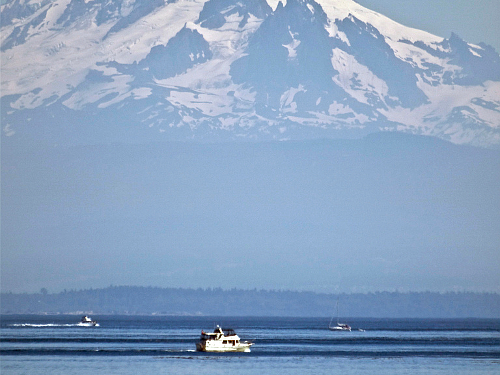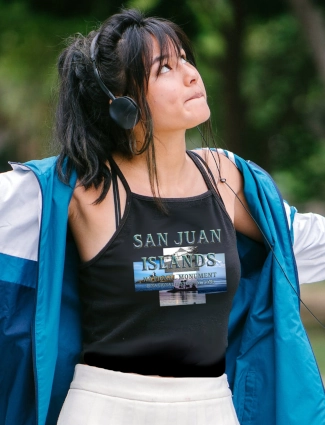
Photo above: English Camp was set up by the British Royal Marines on March 21, 1860 at Garrison's Bay on the northwest coast. Photo courtesy Library of Congress. Right: Scene from the water of San Juan Islands. Photo courtesy Bureau of Land Management.

San Juan Islands National Monument and Historic Site
It's two, yes two, national park or national lands sites all in, well, we'd like to say one, but it's two separate sites. The first, the National Historic Park, is administered by the National Park Service and commemorates the Pig War, a dispute settled without a shot between Great Britain and the U.S.A. over ownership of the island and Friday Harbor. Yes, a pig was killed. And the second, recently added to the roster of National Monuments by proclamation in January 2013 by President Obama, adds the lands within the Bureau of Land Management and still administered by them, into the roster.
Sponsor this page. Your banner or text ad can fill the space above.
Click here to Sponsor the page and how to reserve your ad.

San Juan Islands Then
And yes, there's a bunch of other islands in this chain of four hundred and fifty archipelago islands in Puget Sound and the Straights of Georgia off the main part of Washington State and southern reaches of British Columbia, but, hey, we've got enough to talk about within the national lands pervue, we'll just stick to there. And no, we really don't know why they didn't just combine the two. We're trying not to figure out the why's all the time, even though we're curious, yes we're curious, about it.
In 1853, the Hudson Bay Company established a sheep farm at the southern end of the island. By the time the pig confrontation occurred (yes, it should have been a sheep), there were more than 4,500 sheep on the island.
The San Juan Islands are a land and sea filled with spectacular sights, of the crags along beaches and creatures in the water, of camping sites right on the shoreline to a ferry ride that gives a very good sense, although an expensive one, of the breadth of nature that all of these large and small islands represent. On one of the large islands, San Juan itself, stands the most historic site and event that would shape the history of the area since. There, with two camps on opposite sides of the island, the English and American, the National Park Service tells the story of the swine war that never was. It was a territorial dispute, with both the U.S. and the Washington Territory claiming as well as the British Empire.
In 1859, the story began to unfold at a faster pace, with the British and their sheep farm in the south waging political battle against the Americans settling nearby. They had become common occupiers of the area since Spain had ended their claim to it in 1818 and in 1846 the Oregon Treaty had set the boundaries of U.S. and British Canadian interests, although there was a dispute as to what this meant per the island chain. On June 15, 1859, an American farmer. Lyman Cutlar, shot a British Hudson Bay Company pig, causing a threat of imprisonment. George E. Pickett, U.S. Army infantry, and later a general in the Civil War for the Confederacy, was sent to protect the American settlers. Three British warships were sent to dislodge Pickett; more men and machinery were brought to bear by both sides. And all over the pig. When Washington found out, General Winfield Scott was sent by President Buchanan, and cooler heads prevailed.
English Camp was set up by the British Royal Marines on March 21, 1860 at Garrison's Bay on the northwest coast. They would remain there for twelve years during joint occupation with the Americans before the final settlement was reached, and withdrew from the camp on November 25, 1872. An eventual ruling stated that the land belonged to the United States.
Photo above: Prairie at American Camp, San Juan Islands National Historic Site. Courtesy National Park Service. Below: Strait of Juan de Fuca with Laundress Quarters in the foreground at San Juan Islands National Historic Site. Courtesy National Park Service.

San Juan Islands Now
San Juan Islands National Historic Site - English Camp has a with self-guided walking tour year round and ranger program throughout the summer.
San Juan Islands National Monument - Oh, those lighthouses. There are three within, or right beside, one actually on Coast Guard land, that you can visit when coming to the monument. Patos Island Lighthouse, Turn Point Light Station, and the Cattlepoint Lighthouse provide a glimpse into the maritime history of the area and what a light keeper would be in charge of as he helped guard ships and the sea. There is a museum at the Turn Point Light Station open in the summer.
T-Shirts and Souvenirs

San Juan Islands T-Shirts and Souvenirs. Official gear from America's Best History.

San Juan Islands
Things You Should Not Miss
1. There's really no way to avoid it, at least for most who don't have a plane or their own boat. Take a Ferry Ride to any of the islands of the monument or national historic site. Take in the scenery, look for whales, and watch the world go by.
2. Take in the Pig War walk, which the National Park Service provides from the beginning of June till the end of August on Saturdays at the American Camp. There are other walks and talks throughout the site, usually one per day, but check the visitor center or online for the schedule of events before you make plans.
3. Camp along the shore and let nature take you away from all the distractions of your work and school days. There are camping opportunities at a variety of locations at both the monument and the area around the national historic site.
Photo above: Just one of the islands at San Juan Islands National Monument. Courtesy Bureau of Land Management.

Paint the history of Baseball number by number in books and stats you can get nowhere else. Baseball Evaluation @
statgeekbaseball.com.
Visitor FAQ
San Juan Islands Links
San Juan Island NHP
San Juan Islands National Monument
Washington State Ferries




